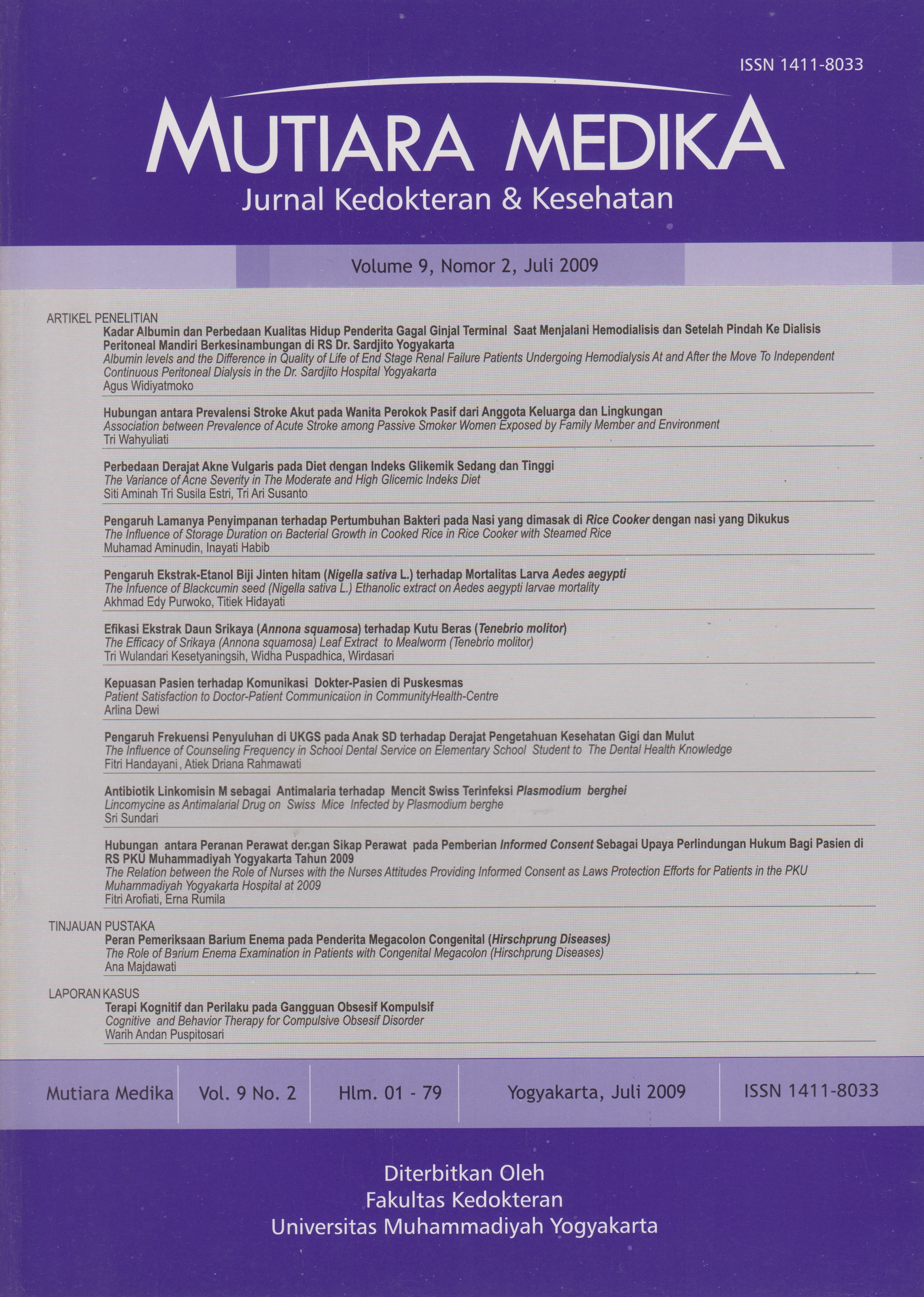Perbedaan Derajat Akne Vulgaris pada Diet dengan Indeks Glikemik Sedang dan Tinggi
DOI:
https://doi.org/10.18196/mmjkk.v9i2.1598Keywords:
akne vulgaris, indeks glikemik, glycemic load Key, Acne vulgaris, glycemic index, glycemic loadAbstract
The exact etiology of acne vulgaris is still unknown. However, few epidemiologic studies on acne vulgaris showed that there is association between diets especially with a high glycemic load, with the incidence of acne vulgaris. The objective of this study is to reveal the correlation between high glycemic load diet and lesion of acne vulgaris prevalence. Sample was 60 students of Medical Faculty, Muhammadiyah University of Yogyakarta, consist of 32 male and 28 female with age from 21 to 22 year. Dietary survey was done without diet intervention for two consecutive months and was analyzed for acne status and glycemic load value at the end of each month. an status akne dan nilai dietuhammadiyah Yogyakarta sebanyak 60 orang terdiri dari 32 orang laki-laki dan 28 orangStatistical analyses were done using Wilcoxon test. The result showed that there was a significant difference (p<0,05) between the average value of glycemic index in the first month (132,78) and the second month (233,5). The average of lesion count in the first month (9,6) and in the second month (12,88) was significantly difference (p<0,05). It is concluded that there were significant differences on lesion count and acne vulgaris severity between the moderate and high glycemic index diets.
Faktor penyebab pasti akne vulgaris masih belum diketahui dengan jelas. Penelitian epidemiologis tentang akne vulgaris menunjukkan adanya hubungan antara makanan, khususnya yang mempunyai indeks glikemik tinggi, dengan insidensi akne vulgaris. Tujuan penelitian ini adalah untuk mengetahui perbedaan derajat lesi pada penderita akne vulgaris dengan indeks glikemik tinggi dan sedang. Jumlah sampel penelitian ini 60 orang mahasiswa Fakultas Kedokteran Universitas Muhammadiyah Yogyakarta, terdiri atas 32 laki-laki dan 28 perempuan. Data diperoleh dengan cara survei makanan sehari-hari selama 2 bulan dan setiap akhir bulan dilakukan pengukuran terhadap glycaemic load dan jumlah lesi akne. Selanjutnya kedua data dianalisis menggunakan tes Wilcoxon. Hasil penelitian ini menunjukkan indeks glikemik diet sehari-hari pada bulan pertama (132,78) dan kedua (233,5) berbeda secara bermakna (p<0,05). Jumlah rerata lesi akne pada bulan pertama (9,6) dan bulan kedua (12,88) juga berbeda bermakna (p<0,05). Kesimpulan: terdapat perbedaan jumlah lesi dan derajat akne vulgaris pada penderita dengan diet dengan indeks glikemik tinggi dan sedang secara bermakna.
References
Cunliffe, W.J., Simpson, N.B., 1998. Disorder of the sebaceous glands. In: Rook, Wilkinson, Ebling, eds. Textbook of Dermatology 6th ed. Blackwell Sciences;812-814
Rzany, B., and Kahl, C., 2006. Epidemiology of Acne Vulgaris, JDDG; 4: 8-9.
Schafer, T., Nienhaus, A., Vieluf, D., Berger, J., Ring, J., 2001, Epidemiology of Acne in The General Population: The Risk of Smoking, Br J Dermatol, 145: 1; 100-104.
Tan, J.K.L., Vasey, K., Fung, K.Y, 2001. Beliefs and perceptions of patients with acne, J Am Acad Dermatol; 44: 439¬45.
Wolf, R., Matz, H., Orion, E., 2004. Acne and Diet, Clinics in Dermatology, 22: 387-93.
Odom, R.B., James, W.D., Berger, T.B., (2003). Andrew's Disease of the Skin. Philadelphia:WB Saunders Company.
Thiboutot, D.M., Strauss, J.S., 2002. Diet and acne revisited. Archives of Dermatology.
Habib, T.P., 2004. Acne Rosacea and related disorder. In: A Color Atlas & Synopsis of Clinical Dermatology 4th ed.; 162-207.
Cordain, L., Lindeberg, S., Huttado, M., Hill, K., Eaton, S.B., Brand-Miller, J., 2002. Acne Vulgaris: A Disease of Western Civilization, Arch Dermatol, 138; 12; 1548-1590.
Achyar, L.Y., Ashadi, L.N., 2001. Cosmeceuticals Anti Akne. Dalam: Wasitaatmaja SM, Rata IGAK (editor): Cosmeceutical, Kumpulan Makalah Semiloka, Jakarta.
Cordain, L., 2005. Implication for the role of diet in Acne, Semin Cutan Med Surg, 24: 84-91.
Adebamawo, C.A., Spiegelman, D., Danby, F.W., Frazier, L,, Willet, W.C., Holmes, M.D., 2005. High School Dietary Dairy Intake and Teenage Acne. J Am Acad Dermatol; 52: 207-14.
Foster-Powell,K., Holt, S.H.A., Brand- Miller, J.C., 2002. International Table of Glycemic Index and Glycemic Load Values: 2002, Am J Clin Nutr ;76:5-56.
Prica, C., Emtestam, L,, Nord, C.E., 2002. Overview of treatment for acne. Dermatology Nursing; 5:301-313.
Smith, N.R., Mann, N.J., Braue, A., Makelainen, H., Varigos, G.A., 2007. The effect of a high-protein, low glycemic- load diet versus a conventional, high glycemic-load diet on biochemical parameters associated with acne vulgaris: A randomized, investigator- masked, controlled trial. J Am Acad Dermatol: 57:247-256.
Downloads
Published
Issue
Section
License
Copyright
Authors retain copyright and grant Mutiara Medika: Jurnal Kedokteran dan Kesehatan (MMJKK) the right of first publication with the work simultaneously licensed under an Attribution 4.0 International (CC BY 4.0) that allows others to remix, adapt and build upon the work with an acknowledgment of the work's authorship and of the initial publication in Mutiara Medika: Jurnal Kedokteran dan Kesehatan (MMJKK).
Authors are permitted to copy and redistribute the journal's published version of the work (e.g., post it to an institutional repository or publish it in a book), with an acknowledgment of its initial publication in Mutiara Medika: Jurnal Kedokteran dan Kesehatan (MMJKK).
License
Articles published in the Mutiara Medika: Jurnal Kedokteran dan Kesehatan (MMJKK) are licensed under an Attribution 4.0 International (CC BY 4.0) license. You are free to:
- Share — copy and redistribute the material in any medium or format.
- Adapt — remix, transform, and build upon the material for any purpose, even commercially.
This license is acceptable for Free Cultural Works. The licensor cannot revoke these freedoms as long as you follow the license terms. Under the following terms:
Attribution — You must give appropriate credit, provide a link to the license, and indicate if changes were made. You may do so in any reasonable manner, but not in any way that suggests the licensor endorses you or your use.
- No additional restrictions — You may not apply legal terms or technological measures that legally restrict others from doing anything the license permits.






